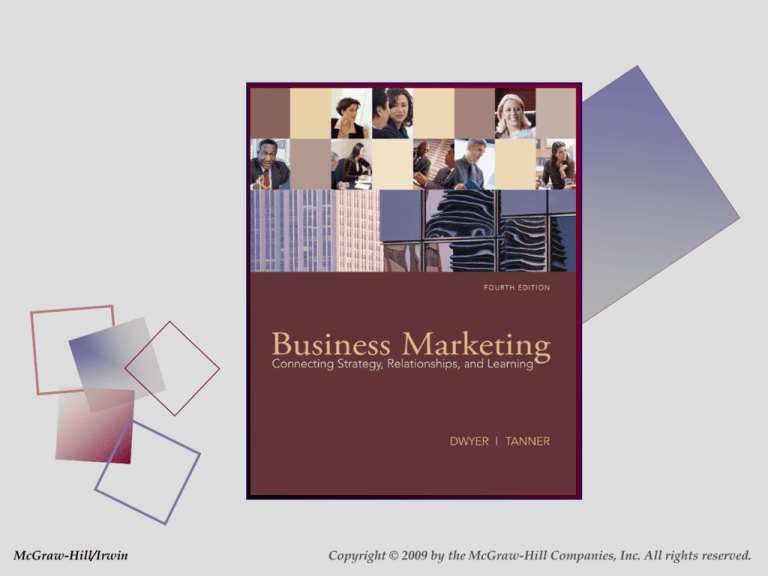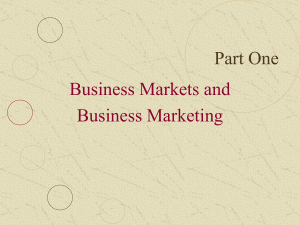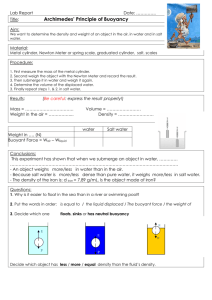
McGraw-Hill/Irwin
Copyright © 2009 by the McGraw-Hill Companies, Inc. All rights reserved.
Part One
Business Markets and
Business Marketing
Part One
Business Markets and Business Marketing
• Chapter 1
•
Introduction to Business Marketing
•
The Character of Business Marketing
•
The Purchasing Function
•
Organizational Buyer Behavior
• Chapter 2
• Chapter 3
• Chapter 4
Chapter 1
Business Markets
and
Business Marketing
BASF EXAMPLE
A TYPICAL BUSINESS-TO-BUSINESS
COMPANY THAT:
•
•
•
•
•
Creates value for its customers
Builds brand recognition
Communicates a unified message
Targets decisions makers
Supports salespeople with variety of
communication tools
1-5
MARKETING SALT
Business marketing Business Marketing
Consumer Marketing
McDonalds
Salt is added to
fries
You
Salt mine
Morton’s Salt
Salt is mined
Salt is processed into
food-grade or
industrial grade salt
Kroger
Salt is sold in
shakers
General Foods
Salt is added to
frozen dinners
Exhibit 1-1
1-6
BUSINESS MARKETING
• THE MARKETING OF GOODS AND
SERVICES TO:
• Companies that consume
• Government Agencies
• Resellers (i.e. wholesalers)
• Institutions (i.e. hospitals)
• Non-Profit Organizations (i.e. American Red
Cross)
FOR USE IN PRODUCING THEIR PRODUCTS
AND/OR TO FACILITATE OPERATIONS
1-7
BUSINESS MARKETING IS UNIQUE
•
•
•
•
•
•
•
•
VARYING INVOLVEMENT LEVELS IN BUYERSELLER RELATIONSHIPS
SHORTER DISTRIBUTION CHANNELS
EMPHASIZES PERSONAL SELLING AND
NEGOTIATION
GREATER WEB INTEGRATION IN
COMMUNICATION
UNIQUE PROMOTIONAL STRATEGIES
CONSUMPTION
KNOWLEDGE OF CUSTOMER’S CUSTOMER
MARKETING RESEARCH
1-8
MARKET DRIVEN MEANS:
•
•
•
•
•
•
ALL EMPLOYEES FOCUS ON CUSTOMER
SATISFACTION
CONSTANTLY SEEKING OPERATIONAL
EFFICIENCY
BUILDING EFFECTIVE EMPLOYEE TERMS
CONSTANTLY IMPROVING SERVICE/SUPPORT
TO CUSTOMERS
BEING INNOVATIVE
DEVELOPING APPROACHES TO OPEN NEW
MARKETS
1-9
TYPICAL BUSINESS TO BUSINESS
GOODS AND SERVICES INCLUDE:
•
•
RAW MATERIALS
•
COMPONENT OR OEM PARTS
(Part of a completed product)
MANUFACTURED MATERIALS
(Transformed from raw materials)
• ACCESSORY EQUIPMENT (Tools)
• CAPITAL EQUIPMENT (Machinery)
• MRO ITEMS (Maintenance, repair and
operation products)
1-10
BUSINESS TO BUSINESS:
IT IS ALL ABOUT RELATIONSHIPS
BUSINESS TO BUSINESS DEPENDS ON:
•
•
Close Business and Personal Relationships
Because of . . . .
Shorter Distribution Channels
Leads to . . . .
•
Emphasis on Personal Selling
Through . . . .
•
Dependence on WEB Integration
and
•
Unique Promotional Strategies
1-11
BUSINESS TO BUSINESS
CHALLENGES
• The size and location of customers – bigger,
fewer, and concentrated
• Strict performance standards for products
by customers
• Complicated purchasing decisions –
Involvement and time
1-12
BUSINESS TO BUSINESS:
IT IS ALL ABOUT DEMAND
• DERIVED DEMAND
• The demand for a company’s products comes from
•
(derived) the demand for their customer’s products.
Most demand originates with consumers.
• JOINT DEMAND
• Two products are used together and demanded
•
together
Both products are consumed at the same time
1-13
BUSINESS TO BUSINESS
DERIVED DEMAND SIMPLIFIED
YOU MAKE HEADLAMP ASSEMBLIES FOR GM
Consumers
want more
cars
Consumers
stop buying
cars
Automobile
manufacturers
produce more cars
Automobile
manufacturers
stop making
cars
You sell more
of your
company’s
headlamp
assemblies
You sell fewer
headlamp
assemblies
1-14
THE FLOW OF GOODS AND SERVICES
Transported via facilitating services
Raw
Materials
Manufactured
materials
SubAssembly
assembly
Component
Finished
parts
car
Purchase order printed facilitating product
Amount and type of car determined by
research facilitating service
Exhibit 1-6
1-15
CREATING VALUE
VALUE IS THE PERCEPTION
OF A PRODUCT’S BENEFIT
BEYOND ITS PRICE
VALUE HAS THREE PARTS:
1. VALUE RECEIVED FROM THE PRODUCT
2. VALUE RECEIVED FROM SELLER’S
SERVICES
3. VALUE RECEIVED FROM RELATIONSHIP
WITH SELLER
1-16
BUSINESS TO BUSINESS: THREE
CRITICAL QUESTIONS FOR A SUCCESSFUL
BUSINESS-TO-BUSINESS PROGRAM
A BUSINESS MUST DETERMINE:
1. WHO ARE ITS CUSTOMERS?
2. WHAT DO ITS CUSTOMERS WANT?
3. HOW DO ITS BUYERS MAKE THEIR
BUYING DECISIONS?
1-17







